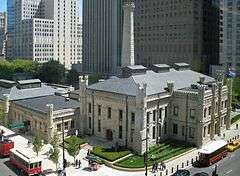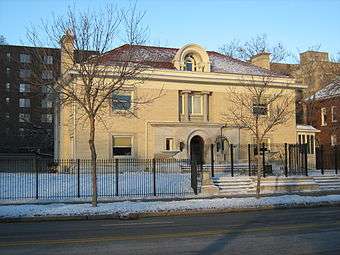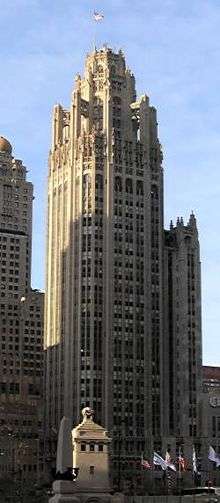Architecture of Chicago
The architecture of Chicago has influenced and reflected the history of American architecture. The city of Chicago, Illinois features prominent buildings in a variety of styles by many important architects. Since most buildings within the downtown area were destroyed by the Great Chicago Fire in 1871 (the most famous exception being the Water Tower)[1] Chicago buildings are noted for their originality rather than their antiquity.
Skyscrapers


Beginning in the early 1880s, architectural pioneers of the Chicago School explored steel-frame construction and, in the 1890s, the use of large areas of plate glass. These were among the first modern skyscrapers. William LeBaron Jenney's Home Insurance Building was completed in 1885 and is considered to be the first to use steel in its structural frame instead of cast iron, but this building was still clad in heavy brick and stone. However, the Montauk Building,[2] designed by John Wellborn Root Sr. and Daniel Burnham, was built in 1882–1883 using structural steel. Daniel Burnham and his partners, John Welborn Root and Charles Atwood, designed technically advanced steel frames with glass and terra cotta skins in the mid-1890s, in particular the Reliance Building;[3] these were made possible by professional engineers, in particular E. C. Shankland, and modern contractors, in particular George A. Fuller.
Louis Sullivan was perhaps the city's most philosophical architect. Realizing that the skyscraper represented a new form of architecture, he discarded historical precedent and designed buildings that emphasized their vertical nature. This new form of architecture, by Jenney, Burnham, Sullivan, and others, became known as the "Commercial Style," but it was called the "Chicago School" by later historians.
In 1892, the Masonic Temple surpassed the New York World Building, breaking its two-year reign as the tallest skyscraper, only to be surpassed itself two years later by another New York building.
Since 1963, a "Second Chicago School" emerged from the work of Ludwig Mies van der Rohe at the Illinois Institute of Technology in Chicago. The ideas of structural engineer Fazlur Khan were also influential in this movement,[4] in particular his introduction of a new structural system of framed tubes in skyscraper design and construction. The first building to apply the tube-frame construction was the DeWitt-Chestnut Apartment Building which Khan designed and was completed in Chicago by 1966.[5] This laid the foundations for the tube structures of many other later skyscrapers, including his own constructions of the John Hancock Center[6] and Willis Tower (then named the Sears Tower)[7] in Chicago and can be seen in the construction of the World Trade Center, Petronas Towers, Jin Mao Building, and most other supertall skyscrapers since the 1960s.[8] Willis Tower would be the world's tallest building from its construction in 1974 until 1998 (when the Petronas Towers was built) and would remain the tallest for some categories of buildings until the Burj Khalifa was completed in early 2010.
Landmarks, monuments and public places
Numerous architects have constructed landmark buildings of varying styles in Chicago. Among them are the so-called "Chicago seven": James Ingo Freed, Tom Beeby, Larry Booth, Stuart Cohen, James Nagle, Stanley Tigerman, and Ben Weese. Daniel Burnham led the design of the "White City" of the 1893 World's Columbian Exposition which some historians claim led to a revival of Neo-Classical architecture throughout Chicago and the entire United States. It is true that the "White City" represented anything other than its host city's architecture. While Burnham did develop the 1909 "Plan for Chicago", perhaps the first comprehensive city plan in the U.S, in a Neo-Classical style, many of Chicago's most progressive skyscrapers occurred after the Exposition closed, between 1894 and 1899. Louis Sullivan said that the fair set the course of American architecture back by two decades, but even his finest Chicago work, the Schlesinger and Meyer (later Carson, Pirie, Scott) store, was built in 1899[9]—five years after the "White City" and ten years before Burnham's Plan.
Sullivan's comments should be viewed in the context of his complicated relationship with Burnham. Erik Larson's history of the Columbian Exposition, The Devil in the White City, correctly points out that the building techniques developed during the construction of the many buildings of the fair were entirely modern, even if they were adorned in a way Sullivan found aesthetically distasteful.[10]
Chicago is well known for its wealth of public art, including works by such artistic heavyweights as Chagall, Picasso, Miró and Abakanowicz that are all to be found outdoors.
City sculptures additionally honor the many people and topics reflecting the rich history of Chicago. There are monuments to:
- Tadeusz Kościuszko by Kazimierz Chodzinski
- Nicholas Copernicus by Bertel Thorvaldsen
- Karel Havlíček Borovský by Joseph Strachovsky
- Pope John Paul II, several different monuments (including by Czesław Dźwigaj)
- Tomáš Garrigue Masaryk by Albin Polasek
- Irv Kupcinet by Preston Jackson
- Abraham Lincoln by Augustus Saint Gaudens
- The Heald Square Monument featuring George Washington, Haym Salomon, and Robert Morris by Lorado Taft, (completed by Leonard Crunelle)
- Christopher Columbus by Carl Brioschi
- General John A. Logan by Augustus Saint Gaudens
- Harry Caray by Omri Amrany and Lou Cella
- Jack Brickhouse by Jerry McKenna
- A memorial to the Haymarket affair by Mary Brogger
- A memorial to the Great Northern Migration by Alison Saar
There are also preliminary plans to erect a 1:1-scale replica of Wacław Szymanowski's Art Nouveau statue of Frédéric Chopin found in Warsaw's Royal Baths along Chicago's lakefront[11] in addition to a different sculpture commemorating the artist in Chopin Park for the 200th anniversary of Frédéric Chopin's birth.
In the 21st century, Chicago has become a leading urban focus for landscape architecture, and the architecture of public places. Building on 19th-20th century legacies of architects such as, Burnham, Frederick Olmstead, Jens Jensen and Alfred Caldwell, modern projects include Millennium Park, Northerly Island, the 606, the Chicago Riverwalk, Maggie Daley Park, and proposals in Jackson Park (Chicago).[12]
Residential architecture
Frank Lloyd Wright's Prairie School influenced both building design and the design of furnishings. In the early half of the 20th century, popular residential neighborhoods were developed with Chicago Bungalow style houses, many of which still exist. Ludwig Mies van der Rohe's Illinois Institute of Technology[13] campus in Chicago influenced the later Modern or International style. Van der Rohe's work is sometimes called the Second Chicago School.
Images
-
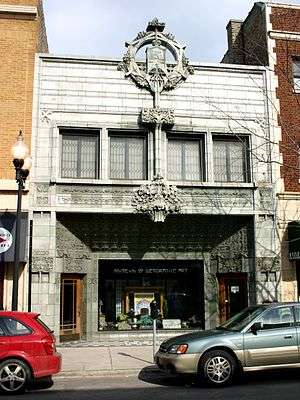
Krause Music Store in Lincoln Square
-
.jpg)
The Gateway Theatre's Solidarity Tower is a replica of the Royal Castle in Warsaw
-

S.R. Crown Hall, by Ludwig Mies van der Rohe
-
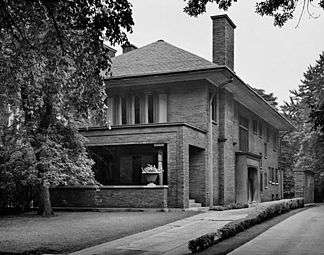
The Ernest J. Magerstadt House by George Washington Maher
-
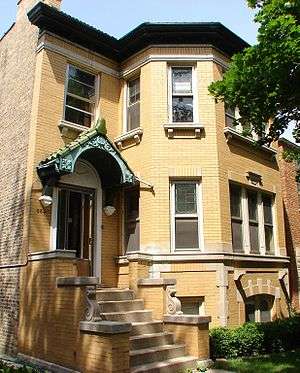
A two-flat in Chicago's Portage Park neighborhood
-
St. Wenceslaus Roman Catholic Church in Avondale where Richard Nickel was married.
-

Interior of Our Lady of Sorrows Basilica, East Garfield Park
-
John Hancock Center, left rear, Water Tower Place, right, and the Chicago Avenue Pumping Station, foreground.
-

Back porches of the distinctive Chicago late 19th-century six-flat apartment buildings
Timeline of notable buildings
Before 1900:
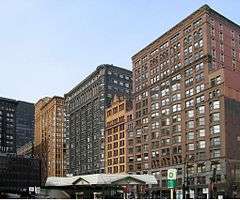



- 1836 Henry B. Clarke House
- 1869 Chicago Water Tower, William W. Boyington
- 1872 Second Presbyterian Church 1936 S. Michigan, James Renwick 1900 Howard Van Doren Shaw
- 1877 St. Stanislaus Kostka Church 1327 N. Noble, Patrick Keely
- 1882–1883 Montauk Building, Daniel Burnham and John Wellborn Root. First building to be called a "skyscraper." (Demolished, 1902)
- 1885 Home Insurance Building, Chicago School, William Le Baron Jenney (Demolished, 1931)
- 1885 Palmer Mansion, early Romanesque and Norman Gothic, Henry Ives Cobb and Charles Sumner Frost (Demolished, 1950)
- 1886 John J. Glessner House, Henry Hobson Richardson
- 1887 Marshall Field Warehouse, Henry Hobson Richardson (Demolished, 1930)
- 1888 Rookery Building, Daniel Burnham and John Wellborn Root, 1905 lobby redesign by Frank Lloyd Wright
- 1889 Monadnock Building, Daniel Burnham and John Wellborn Root
- 1889 Auditorium Building, Louis Sullivan and Dankmar Adler.
- 1889 St. Mary of Perpetual Help Church, Henry Englebert
- 1890 and 1894–1895 Reliance Building, Charles B. Atwood of Burnham & Root
- 1890–1899 Gage Group Buildings, Holabird & Roche with Louis Sullivan
- 1891 Manhattan Building, William Le Baron Jenney
- 1892 Masonic Temple, Daniel Burnham and John Wellborn Root (Demolished, 1939)
- 1892–1893 World's Columbian Exposition, Daniel Burnham, director of Works
- 1893 Palace of Fine Arts, later Museum of Science and Industry, Beaux-Arts, Charles B. Atwood
- 1893-1898 St. John Cantius Church, Alphonsus Druiding
- 1894 Tree Studio Building and Annexes, Judge Lambert & Anne Tree via Parfitt Brothers; 1912 annex: Hill and Woltersdorf
- 1895–1896 Fisher Building (Chicago), D.H. Burnham & Company, Charles B. Atwood
- 1897 St. Paul Church 2234 S. Hoyne, Henry Schlacks
- 1897 Chicago Library (now Chicago Cultural Center), Shepley, Rutan and Coolidge
- 1899 Sullivan Center, Louis Sullivan; 1905–1906, twelve-story south addition, D.H. Burnham & Company
1900-1939:
- 1902 Marshall Field and Company Building, north State Street building D.H. Burnham & Company, Charles B. Atwood
- 1903 Holy Trinity Cathedral, Chicago
- 1905-1906 Holy Trinity Polish Mission, Herman Olszewski and William G. Krieg,
- 1905 Chicago Federal Building
- 1906 Sears Merchandise Building Tower, George G. Nimmons - William K. Fellows
- 1907 Marshall Field and Company Building, south State Street building D.H. Burnham & Company, Charles B. Atwood
- 1909 Robie House, Prairie School, Frank Lloyd Wright
- 1912-1914 St. Adalbert's Church 1650 W.17th street, Henry Schlacks
- 1912 Medina Temple North Wabash Avenue
- 1912 Pulaski Park fieldhouse by Jens Jensen
- 1914 Navy Pier
- 1914-1920 St. Mary of the Angels Church 1850 N. Hermitage Ave, Worthmann and Steinbach
- 1915 Holy Cross Church, Joseph Molitor
- 1916 Navy Pier Auditorium, Charles Sumner Frost
- 1917–1920 Michigan Avenue Bridge, Edward H. Bennett
- 1917-1921 Basilica of St. Hyacinth 3636 West Wolfram Avenue, Worthmann & Steinbach
- 1919-1924 Wrigley Building, Graham, Anderson, Probst & White
- 1921 Chicago Theatre, Beaux-Arts, Cornelius W. Rapp and George L. Rapp
- 1921 Old Chicago Main Post Office, Graham, Anderson, Probst & White
- 1922 Tribune Tower, neo-Gothic, John Mead Howells and Raymond M. Hood
- 1924 Soldier Field, Holabird & Roche; extensive renovation 2003, Ben Wood and Carlos Zapata
- 1925 Uptown Theatre, Cornelius W. Rapp and George L. Rapp
- 1927 Pittsfield Building, Graham, Anderson, Probst and White
- 1929 Carbide & Carbon Building, Daniel and Hubert Burnham, sons of Daniel Burnham
- 1929 Palmolive Building, Art Deco, Holabird & Root
- 1929 John G. Shedd Aquarium, Graham, Anderson, Probst & White
- 1930 Chicago Board of Trade Building, Holabird & Root
- 1930 All Saints Cathedral, J. G. Steinbach
- 1930 Gateway Theatre Mason Rapp of Rapp & Rapp; extensive renovation 1979-1984, "Solidarity Tower" addition in 1985
- 1930 Adler Planetarium & Astronomy Museum, Ernest A. Grunsfeld, Jr.
- 1931 Merchandise Mart, Graham, Anderson, Probst & White
- 1930s-1960s Illinois Institute of Technology, including S.R. Crown Hall, Second Chicago School, Ludwig Mies van der Rohe and Skidmore, Owings & Merrill
- 1934 Field Building, Graham, Anderson, Probst & White
1940 to the present:
- 1940-1942 St. Wenceslaus church, 3400 N. Monticello Ave, McCarthy, Smith and Eppig
- 1952 860–880 Lake Shore Drive, Ludwig Mies van der Rohe
- 1957 Inland Steel Building, Bruce Graham and Walter Netsch, Skidmore, Owings & Merrill,
- 1964 Marina City, Bertrand Goldberg
- 1968 Lake Point Tower, John Heinrich and George Schipporeit
- 1968 Seventeenth Church of Christ, Scientist. Harry Weese
- 1969 John Hancock Center, Bruce Graham, Skidmore, Owings & Merrill
- 1973 330 North Wabash, Ludwig Mies van der Rohe
- 1974 Willis Tower, Bruce Graham, Skidmore, Owings & Merrill (previously the Sears Tower)
- 1974 Aon Center, Edward Durrell Stone (earlier names were Standard Oil Building and Amoco Building)
- 1977 St. Joseph the Betrothed Ukrainian Greek Catholic Church
- 1979-85 James R. Thompson Center, Helmut Jahn
- 1989 NBC Tower, Skidmore, Owings & Merrill
- 1990 American Medical Association Building, Kenzo Tange
- 1990 Athletic Club Illinois Center, Kisho Kurokawa
- 1991 Harold Washington Library Center, Thomas Beeby
- 1991 U.S. Cellular Field, Home of the White Sox
- 1991 Museum of Contemporary Art, Josef Paul Kleihues
- 1992 77 West Wacker Drive, Ricardo Bofill
- 2004 Millennium Park, Frank Gehry, Kathryn Gustafson, Anish Kapoor, Jaume Plensa, and others, a showcase for 21st century modernism.
- 2009 155 North Wacker, Goettsch Partners
- 2009 Trump International Hotel and Tower, Skidmore, Owings & Merrill
- 2010 Aqua Tower, Studio Gang Architects
Styles and schools
Chicago architects used many design styles and belonged to a variety of architectural schools. Below is a list of those styles and schools.
- American Four-Square[14]
- Art Deco/Moderne[14]
- Art Nouveau[15]
- Arts & Crafts[14]
- Chateauesque[14]
- Chicago School[14] (Also called Commercial Style)
- City Beautiful
- Classical Revival[14] (also known as Neoclassical architecture)
- Colonial Revival[14]
- Craftsman[16] (also known as American Craftsman)
- Dutch Colonial[14]
- Eastlake/Stick[14]
- Edwardian architecture[14]
- Gothic Revival[14]
- Greek Revival[14]
- International[14] (sometimes called Second Chicago School)
- Italianate[14]
- Middle Eastern[14]
- Modern
- Oriental[14]
- Prairie School[14]
- Queen Anne[14]
- Renaissance Revival[14] also known as Neo-Renaissance
- Romanesque Revival[14] also known as Neo-Romanesque
- Second Empire[14]
- Spanish Revival[14] also known as Spanish Colonial Revival
- Sullivanesque[14] (for style elements and examples see Louis Sullivan)
- Tudor Revival[14]
- Workers Cottage[14]
Buildings - a "Top Forty" List
In 2010, Chicago Magazine selected 40 still existing properties for their historical and architectural importance,[17] opening an on-line forum for debate. The top ten chosen were:
- 1: John Hancock Center, 875 N. Michigan Ave. (1969)
- 2: Rookery Building, 209 S. LaSalle St. (1885–1888)
- 3: 860-880 Lake Shore Drive Apartments, (1952)
- 4: Monadnock Building, 53 W. Jackson Blvd. (1891 and 1893)
- 5: Carson, Pirie, Scott and Company Building, 1 S. State St. (1899)
- 6: S. R. Crown Hall, 3360 S. State St. (1956)
- 7: Auditorium Building, 430 S. Michigan Ave. (1889)
- 8: Frederick C. Robie House, 5757 S. Woodlawn Ave. (1909)
- 9: Farnsworth House (Plano, Illinois), 14520 River Rd., Plano, IL (1951)
- 10: Sears Tower (now the Willis Tower), 233 S. Wacker Dr. (1974)
See also
- Chicago Architecture Foundation
- Chicago Architecture Biennial
- Open House Chicago
- Chicago Loop
- Chicago neighborhoods
- Landmarks of Chicago
- List of tallest buildings in Chicago
- Parks of Chicago
- Polish Cathedral style
- Visual arts of Chicago
Notes
- ↑ Bach, IraJ. (1980). Chicago’s Famous Buildings. The University of Chicago Press. pp. 106–107. ISBN 0-226-03396-1. LCCN 79-23365.
- ↑ Bach (1980), pp. 15.
- ↑ Bach (1980), pp. 27-28.
- ↑ Billington 1985, pp 234-235
- ↑ Alfred Swenson & Pao-Chi Chang (2008). "building construction". Encyclopædia Britannica. Archived from the original on 5 December 2008. Retrieved 2008-12-09.
- ↑ Bach (1980), pp. 146-147.
- ↑ Bach (1980), pp. 97-98.
- ↑ Ali, Mir M. (2001). "Evolution of Concrete Skyscrapers: from Ingalls to Jin mao". Electronic Journal of Structural Engineering. 1 (1): 2–14. Archived from the original on 16 December 2008. Retrieved 2008-11-30.
- ↑ Bach (1980), pp. 34-37.
- ↑ Devil in the White City.
- ↑ "?".
- ↑ Kamin, Blair (July 19, 2015) "Landscape Design Takes Cemter Stage: Chicago leads way in architecture trend focus on public spaces" Sec 1. p 7.
- ↑ Bach (1980), pp. 182-183.
- 1 2 3 4 5 6 7 8 9 10 11 12 13 14 15 16 17 18 19 20 21 22 23 24 25 "Chicago Landmarks - Style Guide". City of Chicago Department of Planning and Development. Archived from the original on 25 May 2009. Retrieved 2009-05-09.
- ↑ Janet L. Whitmore. "Chicago as an Art Nouveau City - Strand 1: Art Nouveau Cities: between cosmopolitanism and local tradition" (PDF). Art Nouveau European Route : Congress. Retrieved 2014-01-12.
- ↑ "Chicago Landmarks - Craftsman". City of Chicago Department of Planning and Development. Archived from the original on 24 May 2009. Retrieved 2009-05-09.
- ↑ Chicago Magazine Top 40 Buildings in Chicago
References
- Bach, IraJ. (1980). Chicago’s Famous Buildings. The University of Chicago Press. ISBN 0-226-03396-1. LCCN 79-23365.
- Billington, David P. (1985). The Tower and the Bridge: The New Art of Structural Engineering. Princeton University Press. ISBN 0-691-02393-X.
Further reading
- Pridmore, Jay and George A. Larson, Chicago Architecture and Design : Revised and expanded, Harry N. Abrams, Inc., New York, 2005. ISBN 0-8109-5892-9.
External links
| Wikimedia Commons has media related to Architecture of Chicago. |
 Chicago skyline guide travel guide from Wikivoyage
Chicago skyline guide travel guide from Wikivoyage- Online tour of designated Chicago landmarks
- Walking architectural tours of Chicago
- Information on several major Chicago buildings
- Chicago Church Architecture
- American Institute of Architects
- Chicago Architects Project - Society of Architectural Historians

